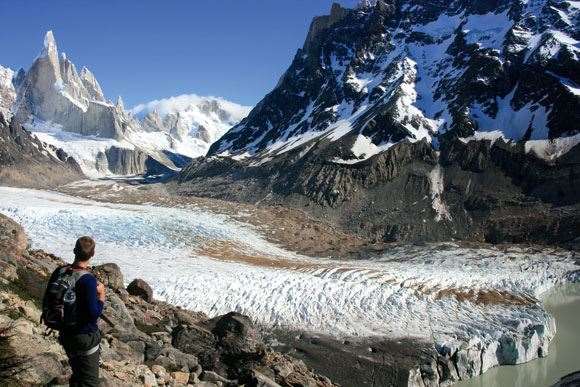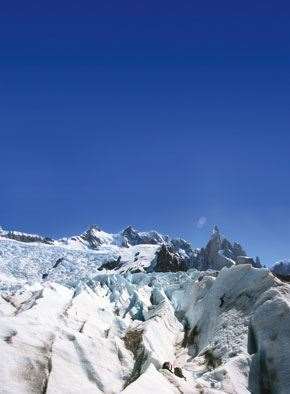When you’re climbing the crevasses of a Patagonian glacier the ice feels as permanent as the granite mountains overhead. But these glaciers are dying fast...
When you’re climbing the crevasses of a Patagonian glacier the ice feels as permanent as the granite mountains overhead. But these glaciers are dying fast...
 Argentina’s Los Glaciares Park is aptly named.
Argentina’s Los Glaciares Park is aptly named.Images: Hillary Stiel
Argentina’s Los Glaciares Park is aptly named. Almost a third of the park is covered by the Patagonic Ice Field, a vast blanket of ice eclipsed in size only by Antarctica and Greenland. Curling from this blanket of ice are 47 glaciers that then branch, like a fractured windshield, into any number of smaller glaciers. Everywhere you look, there’s another glacier – coiling around the foot of a mountain, poking through the opening of a valley, falling down the face of a cliff. And everywhere you look, these glaciers are retreating. The Upsala glacier, a 50km long river of ice, is retreating almost 220m a year, while the Viedma glacier, covering almost 1000 square kilometres, has retreated one and a half kilometres since the mid ’90s. So my goal is this: to clamber across a Patagonian glacier, to climb the walls of its crevasses, before the things disappear altogether.I emerge from the shade of the lenga forest to see the Grande glacier laid out beneath me. It looks impossibly large, a ragged carpet of ice. For most of the year this glacier is raked by a frozen, knifing wind the locals call “la escoba de Dios” – the broom of God. The strength of this wind is difficult to describe – walk into it and you have to adopt a gorilla lope, walk with it at your back and it sends you stumbling like a drunk. It’s a wind more than capable of flipping you over a ridge. But today the sun is fierce and God’s broom is still and the glacier below glitters a piercing blue-white.
The Grande is not the biggest glacier in the area. Compared to the monumental Viedma or Perito Moreno or Upsala – rivers of ice that surge straight out of the Patagonic Ice Field – the Grande is a relative minnow. But for a mountain glacier it’s an impressive sweep. It is, in fact, the confluence of three glaciers – the Grande, the Torre and the Adela – that tumble down the lower slopes of the Torre Range, then coil together to form a two kilometre-wide tongue of ice. At its tip, the Grande empties into the Laguna Torre, a three hectare oval of opaque water that bobs with truck-sized ice bergs. When God’s broom sweeps, this lake is torn into a boiling mess of white-caps that thunder against the bergs. Today it’s dead flat. On the northern shore of the lake rises Mount Fitz Roy, a three and a half kilometre-high knob of granite. To the east, behind the glacier, rises Cerro Torre (3107m), a fabulous needle of pink granite rimmed by drifts of snow and seams of ice. For a time this mountain, first ascended by a quartet of Italians in 1974, was considered the world’s toughest climb.
As we approached the Grande, hiking along a 15km valley of bouldered moraine, the glacier looked smooth and benign. But now we’re closer it takes a different form. At points where the glacier moves fastest – at its edges and steepest points – its skin has fractured. From the valley these points looked shaded and lightly cracked. Now we can see that the fractures are actually vast spines of ice that jut straight up, their razor edges glowing pale blue in the sun before disappearing into shadowy green crevasses gurgling with water. This is where we’re headed.
 The Grande glacier with the needle of Cerro Torre beyond.
The Grande glacier with the needle of Cerro Torre beyond.Image: Hillary Stiel
But my guide, Luis, is not looking at the crevasses – he’s looking at the tip of the glacier. He points to a smooth bubbling of grey rock that rises from the lake: “Last time I was here, maybe six months ago, the ice was touching those rocks.” He shakes his head. Now the face of the glacier stands almost 15 metres back. Standing above the glacier we can hear it creaking and rumbling with hidden rapids of melted water. It sounds like there’s a vast engine thrumming in the heart of the ice. Luis points to the sink holes scattered across the top of the glacier. These are the weak points in the ice where the melted water flows, working at the fissures until they expand into holes that drop to the base of the glacier. Some of the holes are the size of a kitchen sink, others the size of a two-storey house.
An hour later, standing beneath our first wall, a rippling 20m cliff, Luis begins his lesson. “See the blue ice?” he says. “This is the strongest. If the ice is white it has air inside – it is weak. But blue ice is ... ” He searches for the word ... “ is confident. Make the axe in this ice and it will stay.” And this, in short, is the trick to ice climbing – to have confidence in the ice. To have confidence that the four front prongs of your crampons and the two points of your axes – six small blades of steel punched tooth-deep into a wall of ice – will hold your weight. If you have confidence, then ice climbing – according to Luis – is easy. If you loosen your arms and relax into the grip of the axes, if you drop your heels and stand into the clasp of the crampons, then it should feel as elementary as walking up a ladder. But if you don’t have confidence in the grasp of these steel points then your entire body will clench tight as a fist and within half a minute your calves and forearms will be sizzling with acid, your back running with sweat.
I had no confidence on my first climb. “Stand into the crampons,” calls Luis as I bend at the hips and dig my toes at the ice, my knees trembling with effort. “Stand into the crampons!” But standing into shoes that are front-pointing into a cliff is not an easy task. Particularly when the ice is rock-hard and running with water so that my crampons slide across it like they’re carpet slippers. Meanwhile, I can’t get the axe-swing of my left hand right so the point of my axe skitters over the face of the cliff, the handle twisting, leaving my bare knuckles to punch the ice. Admittedly, I am roped to three steel screws that I had wound into the lip of the wall – it’s hardly a life-or-death scenario. But still, a slipped crampon or axe and I go face-first onto the ice which is, of course, cold, wet and rock-hard.
Gradually it comes. My confidence grows and I begin standing into the crampons, hanging my weight from the axes. And climbing the crevasses does become a little like climbing a ladder. Still, when my crampons slide from their grip or my axe dislodges and drops a plate of ice onto my head, I’m reminded of the precariousness of this climbing. At the thought of doing this on the side of a mountain my lip bubbles with sweat. It must be horribly stressful work, inching along the glinting seams of ice that run up the needle of Cerro Torre.
As the afternoon wears on the sun grows hotter. By mid-afternoon I’m down to a T-shirt and my nose is sunburnt. We push further up the glacier. The heat reflecting off the ice grows fierce, the water rushing down the walls of the crevasses grows heavier, the rumbling of water in the bowels of the glacier grows louder. And I’m glad I’m here – perched on these spines of ice – because soon these glaciers might not be.
– Aaron Scott
Related Articles

Socceroos coach says Argentina can only 'play two ways'

Argentina coach on 'inferior' Socceroos: 'I don't fully agree'













